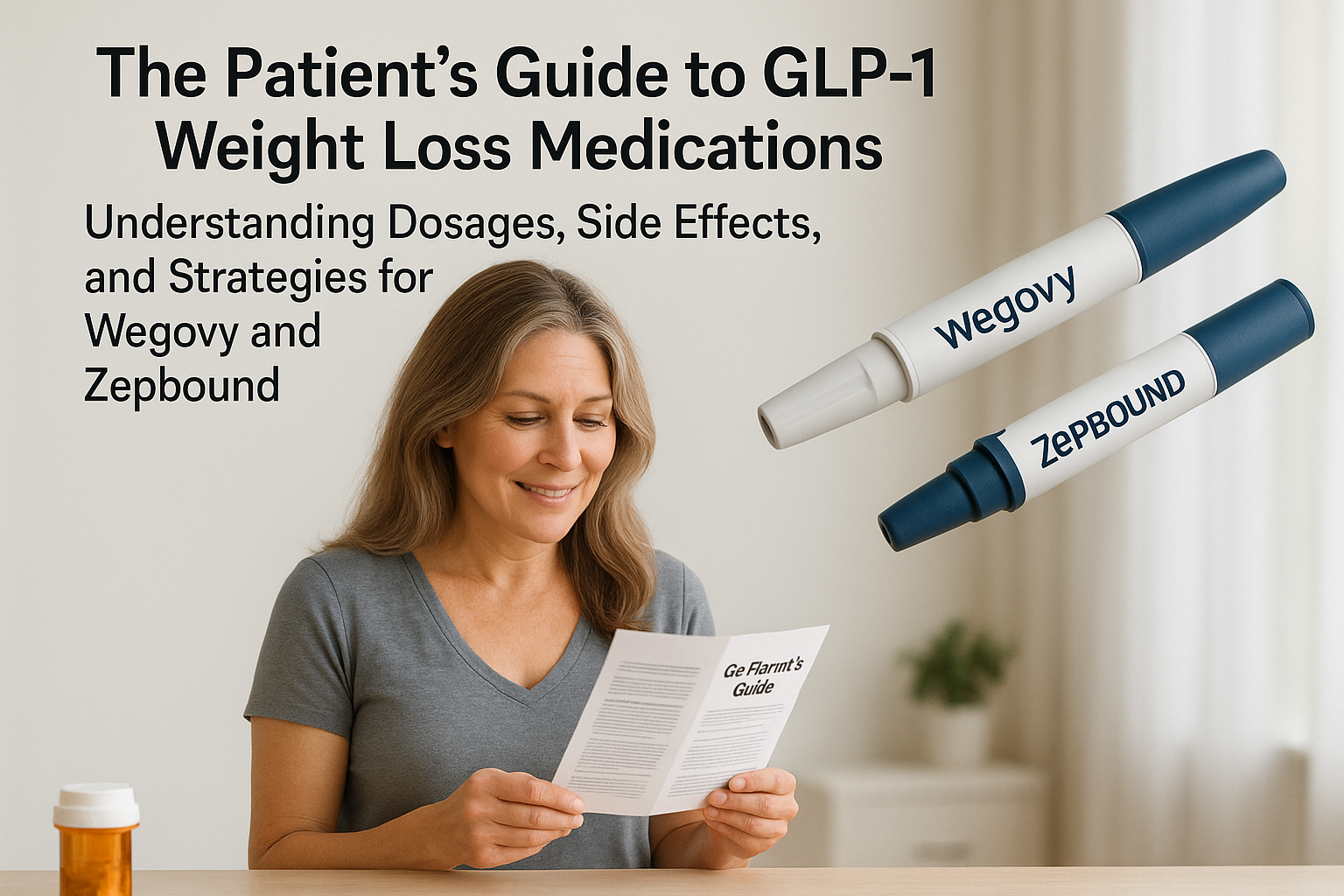The Patient's Guide to GLP-1 Weight Loss Medications: Understanding Dosages, Side Effects, and Strategies for Wegovy and Zepbound

As someone who has navigated the world of GLP-1 medications for weight loss, I know firsthand how overwhelming it can be to understand dosages, manage side effects, and figure out what's "normal" when starting these powerful medications. Whether you're currently taking Wegovy, Zepbound, or considering starting a GLP-1 medication, this comprehensive guide will help you understand what to expect regarding dosages and how to have informed conversations with your healthcare provider.
Understanding GLP-1 Medication Dosing: The Basics
GLP-1 receptor agonists (GLP-1 RAs) like semaglutide (Wegovy) and tirzepatide (Zepbound) work by mimicking a hormone that regulates appetite and blood sugar. Unlike many other medications, these aren't prescribed at a fixed dose. Instead, patients follow a gradual dose escalation schedule to minimize side effects and allow your body to adjust.
Official Dosage Schedules: Wegovy vs. Zepbound
Wegovy (Semaglutide) Dosage Schedule by Novo Nordisk
Wegovy comes in pre-filled pens and follows a 5-step dose escalation:
- Week 1-4: 0.25 mg once weekly (initial dose)
- Week 5-8: 0.5 mg once weekly
- Week 9-12: 1 mg once weekly
- Week 13-16: 1.7 mg once weekly
- Week 17 and onward: 2.4 mg once weekly (maintenance dose)
Zepbound (Tirzepatide) Dosage Schedule by Eli Lilly
Zepbound also uses a step-up approach with pre-filled pens:
- Week 1-4: 2.5 mg once weekly (starter dose)
- Week 5-8: 5 mg once weekly
- Week 9-12: 7.5 mg once weekly
- Week 13-16: 10 mg once weekly
- Week 17-20: 12.5 mg once weekly (if needed)
- Week 21 and onward: 15 mg once weekly (maximum dose)
The Purpose of Starter Doses: More Than Just Getting Started
The first two doses (0.25mg and 0.5mg for Wegovy; 2.5mg and 5mg for Zepbound) serve multiple important purposes:
1. Tolerance Testing: These lower doses help determine how your body reacts to the medication. Think of them as "trial doses" that allow both you and your doctor to observe any adverse reactions before committing to higher doses.
2. Side Effect Management: By starting small, your body can gradually adapt to the medication, potentially reducing the severity of side effects like nausea, vomiting, and digestive issues.
3. Preparation for Therapeutic Doses: The initial doses rarely produce significant weight loss for most patients. Their primary purpose is to prepare your body for the higher, more therapeutically effective doses to come.
4. Personal Response Assessment: Everyone responds differently to these medications. The starter doses give you and your doctor valuable information about how your unique body processes GLP-1 medications.
Real-World Dosing Strategies: What Doctors Actually Do
While manufacturers provide official dosing schedules, many healthcare providers customize dosing approaches based on individual patient needs:
The Standard Approach
Following the manufacturer's recommended schedule with dose increases every 4 weeks. This is the most common approach and aligns with clinical trial protocols.
The "Low and Slow" Method
Some doctors keep patients on lower doses for longer periods, especially if they're experiencing good weight loss results with minimal side effects. For example, a patient might stay at 1mg of Wegovy for 8-12 weeks instead of the standard 4 weeks if they're losing weight steadily and comfortably.
The "Pause and Hold" Strategy
If side effects become problematic, doctors may keep patients at their current dose longer than the recommended 4 weeks, allowing more time for adjustment before increasing.
The "Skip-a-Step" Approach
For patients experiencing minimal side effects and seeking faster results, some providers might accelerate the schedule by skipping certain intermediate doses. However, this approach increases the risk of more severe side effects.
The "Micro-Dosing" Technique
Some practitioners have experimented with dividing weekly doses into smaller twice-weekly injections to help manage side effects, though this is considered off-label use.
Side Effects Across Different Dosage Levels
Side effects typically intensify with each dose increase, though the pattern varies significantly between individuals:
Starter Doses (Wegovy 0.25-0.5mg, Zepbound 2.5-5mg)
- Common: Mild nausea, reduced appetite, occasional constipation
- Less common: Mild heartburn, slight fatigue
- Rare at this stage: Severe vomiting, intense gastrointestinal distress
Middle Doses (Wegovy 1-1.7mg, Zepbound 7.5-10mg)
- Common: Moderate nausea (often worse after meals), constipation, occasional vomiting, delayed gastric emptying (feeling full longer)
- Less common: Headaches, fatigue, sulfur burps, acid reflux
- Rare but reported: Hair thinning (typically temporary), gallbladder issues
Maintenance Doses (Wegovy 2.4mg, Zepbound 12.5-15mg)
- Common: All of the above, potentially more pronounced
- Additional concerns: Muscle loss if protein intake isn't adequate
- Long-term considerations: Nutritional deficiencies due to reduced food intake, delayed gastric emptying
Tolerance Development: Does the Effect Diminish Over Time?
A question frequently discussed in patient forums is whether GLP-1 medications lose effectiveness over time. The research suggests:
Short-term Adaptation
Some patients report that nausea and other side effects diminish after several weeks at a stable dose, suggesting the body adapts to some of the medication's effects.
Weight Loss Plateaus
Many patients experience a natural slowing of weight loss after 6-12 months, which isn't necessarily medication resistance but rather the body reaching a new equilibrium. Clinical trials show continued (though decreased) effectiveness beyond the first year.
True Pharmacological Tolerance
Some research suggests that a small percentage of patients may develop antibodies against semaglutide, potentially reducing its effectiveness. However, this appears to be uncommon and varies by medication.
Managing Potential Tolerance
- Regular dose adjustments based on response
- Combining with other weight management strategies
- Periodic reassessment of effectiveness
The Impact of Starting and Stopping: The Yo-Yo Effect
Whether due to insurance issues, medication shortages, side effects, or planned breaks, many patients experience interruptions in their GLP-1 treatment. Here's what the research and patient experiences suggest:
The Effects of Pausing Treatment
Weight Regain Patterns:
- Most patients regain some weight after stopping GLP-1 medications
- Clinical studies show average regain of 2/3 of lost weight within a year of discontinuation
- The rate of regain varies widely between individuals
Metabolic Changes:
- Appetite signals return, sometimes stronger than before
- Food cravings that were suppressed may rebound
- Blood sugar regulation benefits diminish
Restarting After a Break
Re-initiating Treatment Protocol:
Most providers recommend restarting at a lower dose (though not necessarily the very lowest) after breaks of:
- 2-4 weeks: Often restart one dose level below previous dose
- 1-3 months: Often restart at about half the previous dose
- 3+ months: Frequently restart the entire dosing schedule
Side Effect Patterns When Restarting:
- Many patients report stronger side effects when restarting
- Some experience a "honeymoon" period with rapid weight loss upon restarting
- Others find side effects milder than their initial experience
Research Insights on Dosage Schedules
Several clinical studies offer insights that patients should be aware of when discussing dosage strategies with their healthcare providers:
The STEP Trials (Semaglutide Treatment Effect in People with Obesity)
- Higher maintenance doses (2.4mg) showed significantly better outcomes than lower doses (1mg)
- Weight loss continued for approximately 60 weeks before plateauing for most participants
- Participants who maintained the medication experienced better weight maintenance than those who stopped
The SURPASS Trials (Tirzepatide)
- Dose-dependent weight loss with each higher dose showing increased effectiveness
- The 15mg dose showed nearly 25% body weight reduction in some participants over 72 weeks
- Higher doses had increased gastrointestinal side effects but most were tolerable with time
Patient-Relevant Research Findings
Titration Speed:
Research suggests that patients who follow the recommended 4-week intervals between dose increases tend to have better long-term adherence than those who accelerate or rush through dose increases.
Duration of Treatment:
Studies indicate that GLP-1 medications are most effective when viewed as long-term treatments. Current research supports continuous use for at least 1-2 years for maximal benefits, with ongoing treatment likely necessary for maintenance.
Cycling On/Off:
Limited research exists on cyclical use (e.g., 3 months on, 1 month off), though some practitioners are exploring this approach to mitigate concerns about long-term continuous use.
Additional Considerations for GLP-1 Medication Patients
The Dosage-Diet Connection
Higher doses tend to cause stronger appetite suppression, which can lead to inadequate nutrition. As your dose increases, working with a dietitian becomes increasingly important to ensure you're getting sufficient protein, vitamins, and minerals despite eating less.
Hydration Requirements
Many side effects worsen with dehydration. Higher doses often require more intentional hydration strategies (aim for 2-3 liters daily).
Medication Timing Strategies
- Injecting before bed instead of morning may help some patients sleep through initial nausea
- Consistent injection timing (same day/time weekly) helps maintain steady drug levels
- Some doctors recommend taking a dose after a small protein-based meal rather than on an empty stomach
Complementary Medications
Many providers prescribe supplemental medications to manage side effects at higher doses:
- Anti-nausea medications like ondansetron (Zofran)
- Stool softeners or motility agents for constipation
- Acid reducers for reflux and heartburn
Having Productive Conversations With Your Doctor About Dosage
When discussing your GLP-1 medication dosage with your healthcare provider, consider these talking points:
Questions to Ask Your Doctor
- "Given my specific health situation, should we consider a slower or faster dose escalation than standard?"
- "What side effects should prompt me to contact you versus which are expected and manageable?"
- "How long should I expect to stay at each dose level?"
- "What metrics besides the scale should we use to evaluate if the current dose is working?"
- "What is your approach if I hit a plateau at a given dose?"
Information to Track and Share
- Specific side effects and their severity
- Pattern of weight changes at each dose
- Food tolerance changes and appetite levels
- Energy levels and mood changes
- Changes in health markers (blood pressure, blood sugar, etc.)
Conclusion: Personalization is Key
While manufacturers provide standardized dosing schedules for GLP-1 medications, the optimal approach varies significantly between individuals. By understanding the purpose behind dosage strategies, being aware of what to expect at different doses, and maintaining open communication with your healthcare provider, you can develop a personalized plan that maximizes benefits while minimizing side effects.
Remember that these medications represent just one tool in a comprehensive weight management approach. The most successful patients combine appropriate medication dosing with sustainable dietary changes, regular physical activity, stress management, and addressing the psychological aspects of their relationship with food.
Disclaimer: This article is based on current research and patient experiences but should not replace medical advice. Always consult with your healthcare provider before making any changes to your medication regimen.

